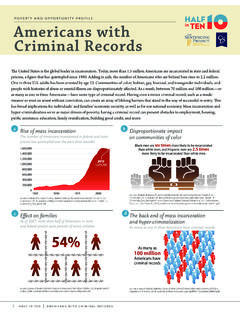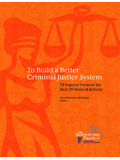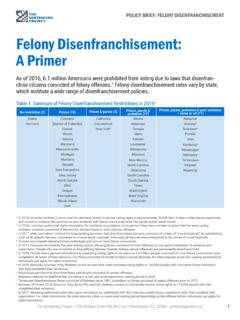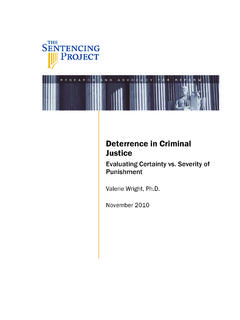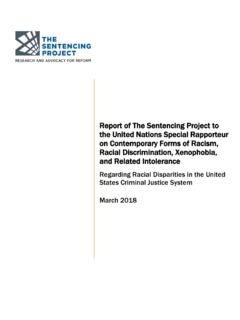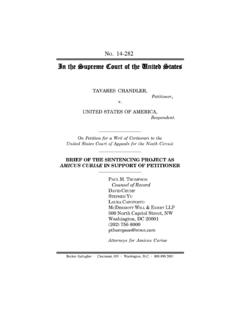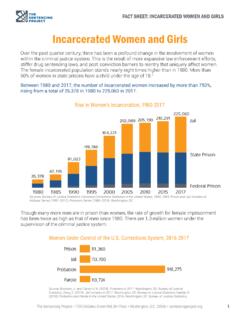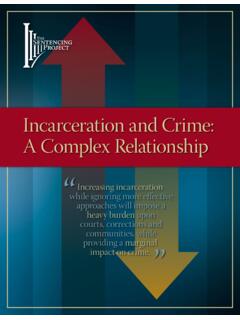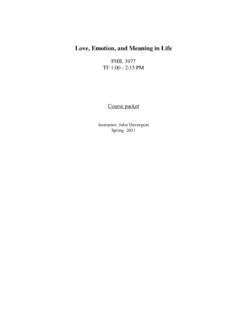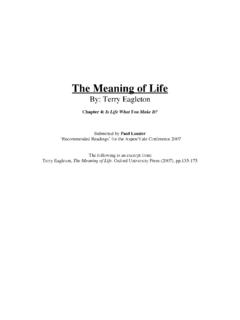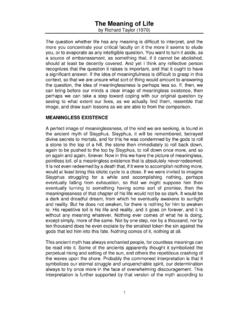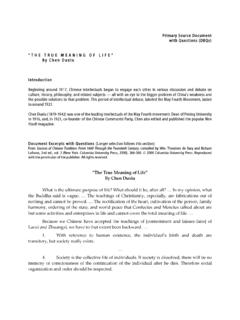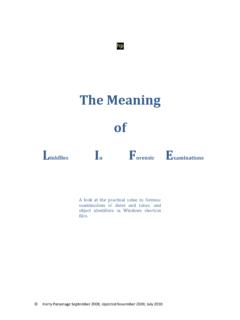Transcription of THE MEANING OF “L L C B M , R S. K M 2004
1 THE MEANING OF life :LONG PRISON SENTENCES IN CONTEXTBYMARC MAUER, RYAN S. KING, AND MALCOLM C. YOUNGMAY 2004 514 10TH STREET NW, SUITE 1000 WASHINGTON, DC 20004 TEL: FAX: report was written by Marc Mauer, Ryan King, and Malcolm C. Young, Assistant Director,Research Associate, and Executive Director respectively, of The Sentencing Project. Researchassistance was provided by Michael Coyle. The authors wish to thank the following forproviding information and insight into the issues covered in the report: John Anderson, WilliamDiMascio, Elizabeth Leonard, Barbara Levine, Sue Osthoff, David Saxner, and Mara Taub. Andparticular appreciation to Douglas Dennis and staff of The Angolite, who have produced strongjournalism on these issues for many Sentencing Project is a national non-profit organization engaged in research and advocacyon criminal justice policy issues.
2 Funding for this project was supported by grants from theJEHT Foundation, John D. and Catherine T. MacArthur Foundation, Open Society Institute, andindividual 2004 by The Sentencing Project. Reproduction of this document in full or part inprint or electronic format only by permission of The Sentencing further information:Malcolm C. YoungThe Sentencing Project514 10th St. NWSuite 1000 Washington, 20004(202) s a popular misconception that life in prison doesn t mean all of one snatural life . In just the last year, there are 21 Georgia lifers who are no longeraround to tell you otherwise. If they could, they d let you know that parole for alife sentence is a rare Georgia State Board of Pardons and ParoleA crime prevention policy which accepts keeping a prisoner for life even if he isno longer a danger to society would be compatible neither with modern principleson the treatment of prisoners during the execution of their sentence nor with theidea of the reintegration of offenders into Council of EuropeOver the past three decades the political climate in the United States has increasingly embraced get tough policies as the primary focus of a crime control strategy.
3 These policies have beenwide-ranging in their impact, and include such features as high levels of drug law enforcement,greater reliance on determinate sentencing, and most significantly, a vastly expanded use ofimprisonment. Along with these changes has come a virtual abandonment of the principles ofrehabilitation that had been central to the nation s correctional philosophy, even if not alwaysimplemented to a significant degree, as recently as the the past several years there has been a significant shift both in public discussion and policyattention to the use of imprisonment. At the state level, many policymakers are now advocatingchanges in sentencing policy and practice that reflect new thinking and options for lower-leveldrug offenders in particular.
4 These proposals emphasize shorter prison terms and/or diversion totreatment programs for cases in which substance abuse is an underlying contributor to crime, andfor which it is believed that these approaches will provide greater public safety contrast to these developments, a variety of policy changes beginning in the 1970s andincreasing in recent decades have set in motion a movement to extend considerably the length oftime that other offenders spend in prison. These changes include such policies as mandatorysentencing, truth in sentencing, and cutbacks in parole release. While many of these initiativesapply primarily to persons convicted of a violent offense, in some cases they mandate long-termincarceration even for persons convicted of property or drug among the changes affecting the prison population in recent years are laws affecting lifers, those persons receiving a sentence that may result in an offender never being releasedfrom Policy considerations for persons sentenced to life are very different than foroffenders who appear far less threatening, such as low-level drug offenders.
5 For violent 1 News release, Georgia State Board of Pardons and Paroles, More Violent-Crime Lifers Die in Prison Than AreParoled, June 1, life Imprisonment, United Nations, 1995, The term life sentence has been used in a variety of ways over time and consequently there is much publicconfusion regarding its MEANING . While the intuitive definition of a life sentence is a prison term for the remainderof one s natural life , in fact the term also includes various indeterminate sentences, or sentences whose length can bereduced by commutation, parole, or MEANING OF life : LONG PRISON SENTENCES IN CONTEXT 2_____offenders who have taken lives or who pose a serious threat to public safety, incapacitation as ameans of assuring public safety is a legitimate and compelling concern at sentencing.
6 Inaddition, under current laws and sentencing philosophies, lifetime incarceration is deemed anappropriate punishment for the harm done by serious violent , the issue of life sentences is far more complex and cannot be regarded as merely strictsentencing for a deserving population of serious violent offenders. A closer examination of thenumber of people serving life sentences, their offense characteristics, and the judicial process bywhich their sentences were imposed, challenges many of the assumptions about the compositionof the lifer population. Among those serving life are persons who themselves have notcommitted violent acts and others whose life circumstances suggest they are more vulnerablethan violent. A selection of such cases is highlighted throughout this notable in this regard is California s three strikes and you re out law, under which anyfelony following two previous strikes can result in a life term in prison.
7 A recent high-profileexample is the case of Leandro Andrade, whose third strike involved thefts of children svideotapes worth $153 and intended as Christmas gifts for his nieces. In affirming theconviction, the Supreme Court upheld the California law in 2003 and he is now serving asentence of 50 years to s three strikes law is not an isolated example. Other policy changes in recent yearshave led to life sentences being imposed on a significant number of people for whom suchsentences may not have been intended or for whom they are not necessarily appropriate. Further,opportunities which previously existed to review and modify life sentences which proved longerthan necessary have been reduced or eliminated in many states. These changes have come aboutat a time of increased concern about the possibility of unjust convictions and sentencing, asdramatically evidenced in the imposition of the death penalty.
8 4 Lockyer v. Andrade, 538 63 (2003), decided with Ewing v. California, 538 11 (2003).Santos ReyesIn 2003 a federal appeals court upheld a three strikes sentence of 26 years to life for Santos Reyes,whose third strike in California involved trying to take the written portion of a driver s license test forhis illiterate cousin. The court ruled that Reyes claim of cruel and unusual punishment had beenforeclosed by a previous ruling on the law by the Supreme Court. Reyes admitted his perjury infilling out the license application, stating that his cousin needed the license in order to work as aroofer. The conviction followed two previous offenses, one for a juvenile burglary conviction in 1981and another for an adult robbery conviction in 1987.
9 Reyes had been offered a four-year prison termif he pled guilty, but chose to go to trial, believing he could demonstrate that he had not understoodwhat constituted perjury when he took the exam. At the time of his sentencing in 1998, Reyes wasmarried and had children ages 1 and MEANING OF life : LONG PRISON SENTENCES IN CONTEXT 3_____In this report we assess the dramatic increase in the imposition of life sentences in the context ofincapacitation and public safety, fiscal costs, and the sentencing goal of punishment, includingthe implications for both victims and offenders. Major findings of the report include: One of every 11 ( ) offenders in state/federal prison 127,677 persons is now serving alife sentence.
10 Of the lifers in prison, one in four ( ) is serving a sentence of life without parole, havingincreased from one in six ( ) in 1992. The number of lifers in prison rose by 83% from 69,845 in 1992 to 127,677 in 2003. Time to be served for lifers admitted to prison increased by 37% from 1991 to 1997, risingfrom years to 29 years. In six states -- Illinois, Iowa, Louisiana, Maine, Pennsylvania, and South Dakota -- all lifesentences are imposed without the possibility of parole. Seven states -- Alabama, California, Florida, Illinois, Louisiana, Michigan, and Pennsylvania-- have more than 1,000 prisoners each serving sentences of life without parole. The increase in prison time for lifers is a result of changes in state policy and not continuousincreases in violent crime. Four of every five ( ) lifers released in 1994 had no arrests for a new crime in the threeyears after their release.
